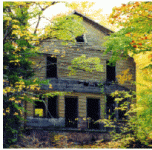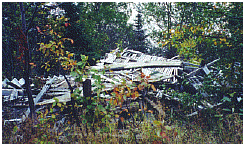Gypsy Heart
Gold Member
- #1
Thread Owner
The old Mandan Location is situated 12 miles south of Copper Harbor on Highway 41. Turn east at the rustic sign and you will find the remains of this once busy mining area.
Most of the buildings have fallen down or will shortly, but there are three or four that still stand and are occupied by summer residents.

The original Mandan Company was organized in 1864. According to The Copper Handbook, Mandan was a tract of 529 acres lying just east of the Resolute Mine in Keweenaw County.
The Medora Mine lies just next to it. The mine dump next to the village is from the Medora Mining Company as the Mandan dump is just west of the town and very difficult to find.
The mine evidently underwent considerable hardship as there were huge beds of sand that made it difficult to mine the four inch wide band of very rich copper.
It is assumed that the mine closed in 1866 and remained dormant until 1899 when the Mandan and Medora Companies were sold to the Keweenaw Copper Company and reorganized in 1905.
Diamond drills were now being used but development was confined to the Medora lode until 1907 when another shaft was started west of the Mandan exploration.
The village was a busy place with a population of about 300 people with about 25 houses, a second boarding house heated with steam, and a school built around 1907, all constructed by carpenters of the mining company.

The first early boarding house accommodated about 15-20 men, who lived there in "double shifts." When the day shift was at work, the night shift was asleep.
All the supplies had to be brought in to Copper Harbor by boat in November and last until May when the waterways opened. If the weather was too bad for the boat to make the last run, serious shortages developed.
Gardens were not plentiful as there was very little cleared land and the growing season was very short. Apples were about the only fresh fruit since they could be kept for a length of time and had so many uses.
A general store operated by J.P. Peterman was opened in 1908. Mr. Peterman had several stores in the local area. The store was closed in 1911 and the stock was moved to Phoenix.
Mandan had no churches, but the residents were visited by clergymen from time to time and services were held in one of the homes.
The railway depot just east of the village was the end of the line for the Keweenaw Central Railroad and included a telegraph, Wells Fargo and Company Express office. There was a post office in Mandan from 1908 until 1931.
Copper was evidently not found in the amount expected and the mines reduced the number of workers. This was not too great a hardship however, as these men were able to obtain work at the Cliff or the Ojibway.
In September of 1909, all operations were suspended as the underground conditions did not improve. Many people left the area and the village fell into disrepair and very little remains
Most of the buildings have fallen down or will shortly, but there are three or four that still stand and are occupied by summer residents.
The original Mandan Company was organized in 1864. According to The Copper Handbook, Mandan was a tract of 529 acres lying just east of the Resolute Mine in Keweenaw County.
The Medora Mine lies just next to it. The mine dump next to the village is from the Medora Mining Company as the Mandan dump is just west of the town and very difficult to find.
The mine evidently underwent considerable hardship as there were huge beds of sand that made it difficult to mine the four inch wide band of very rich copper.
It is assumed that the mine closed in 1866 and remained dormant until 1899 when the Mandan and Medora Companies were sold to the Keweenaw Copper Company and reorganized in 1905.
Diamond drills were now being used but development was confined to the Medora lode until 1907 when another shaft was started west of the Mandan exploration.
The village was a busy place with a population of about 300 people with about 25 houses, a second boarding house heated with steam, and a school built around 1907, all constructed by carpenters of the mining company.
The first early boarding house accommodated about 15-20 men, who lived there in "double shifts." When the day shift was at work, the night shift was asleep.
All the supplies had to be brought in to Copper Harbor by boat in November and last until May when the waterways opened. If the weather was too bad for the boat to make the last run, serious shortages developed.
Gardens were not plentiful as there was very little cleared land and the growing season was very short. Apples were about the only fresh fruit since they could be kept for a length of time and had so many uses.
A general store operated by J.P. Peterman was opened in 1908. Mr. Peterman had several stores in the local area. The store was closed in 1911 and the stock was moved to Phoenix.
Mandan had no churches, but the residents were visited by clergymen from time to time and services were held in one of the homes.
The railway depot just east of the village was the end of the line for the Keweenaw Central Railroad and included a telegraph, Wells Fargo and Company Express office. There was a post office in Mandan from 1908 until 1931.
Copper was evidently not found in the amount expected and the mines reduced the number of workers. This was not too great a hardship however, as these men were able to obtain work at the Cliff or the Ojibway.
In September of 1909, all operations were suspended as the underground conditions did not improve. Many people left the area and the village fell into disrepair and very little remains





